Clean Rooms


Pass boxes (sometimes called transfer hatches) are buffer chambers used to transfer materials, tools, or waste between contiguous cleanrooms (or between zones of differing cleanliness) without opening doors that breach the pressure/airflow regime. They help reduce the risk of particulate or microbial ingress.
- Static Pass Boxes
These are simple, air-tight chambers with interlocked doors on each side. The operator loads an item on one side, closes that door; after the internal environment stabilizes (or waiting period elapses), the opposite door can open. There is no active airflow inside; the design relies on the cleanliness of adjacent zones and the time between access.
- Dynamic (or Air-Flow / Air-Curtain) Pass Boxes
In a dynamic configuration, a unidirectional airflow (e.g. HEPA-filtered laminar flow) is introduced within the pass box to create a clean air curtain or overpressure inside the box. This provides extra assurance against particulates moving inwards. Interlocks and airflow sequencing ensure that both doors are never open simultaneously and that the pressure differential is maintained.
Schematic’s Approach
- Custom-designed pass boxes matched to cleanroom standards (ISO 5, 6, 7, etc.)
- Interlocked doors with fail-safe mechanisms
- HEPA / ULPA filtration options in dynamic units
- Material compatibility (316L, electropolished surfaces) and sanitary hygiene design
- Integration with building controls or room monitoring (door status, pressure, cycle logging)
- Validation support (e.g. particle counts, airflow verification)
Pass boxes serve as modular “clean gates” to enable material flow while preserving the integrity of the clean zones without resorting to full gowning or compromising differential pressures.

Ultraviolet C, at certain frequencies, irradiation is a proven method for inactivating microorganisms (bacteria, viruses, spores) on exposed surfaces and in thin air layers — when properly deployed. It offers a non-chemical, residue-free disinfection method that can supplement or replace manual wiping or fogging in certain cleanroom contexts.
Automated UV-C modules are often used in pass boxes, small chambers, or enclosure surfaces between cycles, or in tool/fixture decontamination.
Key Design Considerations
- Shielding / interlock to ensure no human exposure during irradiation
- Timer control, intensity monitoring, safety cut offs
- Reflection / scattering control to ensure uniform irradiation
- Material compatibility (UV stability of interior surfaces)
- Validation (dosimetry, UV dose mapping)
- Occupancy detection or interlock logic to prevent inadvertent exposure (e.g. coupling UV cycles with door states)
Literature supports coupling UVC systems with occupancy sensors to maximize safety while maintaining disinfection efficacy.
Schematic can integrate UV-C modules into pass boxes, workstations, or cleanroom airlocks to provide on-demand decontamination cycles with traceable control.

Barrier systems such as glove boxes, isolators, and containment enclosures rely on the integrity of gloves (or glove sleeves) to maintain isolation. A failure (micro-leak) can compromise the clean environment or expose operators to hazardous materials.
Schematic’s Smart Glove Leak Tester
- Designed to test glove integrity remotely (without breaching the clean zone) in accordance with ISO 14644-7 procedures.
- Software compliant with 21 CFR Part 11 for audit and electronic record-keeping.
- Ergonomic, lightweight design with wireless (WiFi/Bluetooth) connectivity, operable via tablet or mobile device.
- Capable of testing large numbers of glove ports (e.g. up to 100 gloves per cycle) with built-in pressure sensors and automated routines.
- Enables “remote” testing—i.e. the testing engineer does not need to enter the clean space, reducing risk and gowning cycles.
By providing rapid, automated leak detection, the smart tester bolsters barrier reliability, supports preventive maintenance, and helps satisfy regulatory scrutiny.

Personnel decontamination showers are critical safety assets in facilities handling hazardous, potent, or toxic substances. In case of accidental exposure or spill, these systems enable rapid wash-down to minimize absorption or injury.
Schematic offers Dual (two-door) Decontamination Showers as well as Single showers.
- Dual Decontamination Showers: equipped with two doors (entry/exit) and electronic interlocks, they allow simultaneous entry and egress during wash-down cycles. The doors are sequenced to ensure that only one side is accessible at a time, preserving containment and safety.
- Single Decontamination Showers: simpler one-door versions for less complex zones, also with interlocks and timed cycles.
These showers are built in stainless steel, supplied as turnkey systems, and tied into facility safety or process control systems for interlock behavior and emergency response.
In cleanroom / containment environments, such showers may be placed at access points to hazardous zones, or near glove boxes/isolator rooms to handle inadvertent exposure risk.



